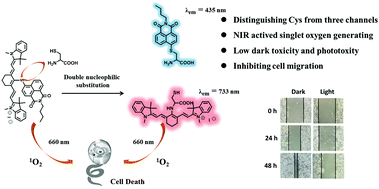A mitochondria-targeted fluorescent dye naphthalimide-thioether-cyanine for NIR-activated photodynamic treatment of cancer cells†
Abstract
In this work, an NIR-activated fluorescent dye naphthalimide-thioether-cyanine (NPSCY) was developed for the photodynamic treatment of cancer cells. In this dye, naphthalimide and cyanine were selected as the two fluorophores, which were linked by the thioether group. Under 660 nm irradiation, NPSCY could produce 1O2 rapidly, suggesting the potential for photodynamic therapy. Cys can be considered as one of the markers of cancer cells and NPSCY could distinguish Cys from three channels (433 nm, 475 nm, 733 nm) due to the bilateral recognition of the thioether group, which was helpful for accurately locating cancer cells. Fortunately, NPSCY could also produce 1O2 after being reacted with the intracellular biological thiols, which also avoided the inactivation of the photosensitizer in cancer cells. The co-localization coefficient of 0.873 indicated that the cyanine group promoted the aggregation of NPSCY in mitochondria. This photosensitizer showed low dark toxicity and high phototoxicity. Meanwhile, the half-maximal inhibitory concentration (IC50) was calculated to be 3.7 μM. NPSCY could inhibit cell migration after irradiation at 660 nm.



 Please wait while we load your content...
Please wait while we load your content...